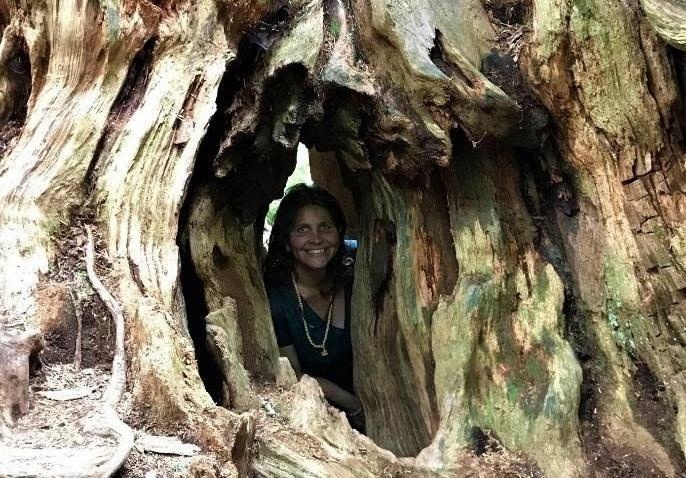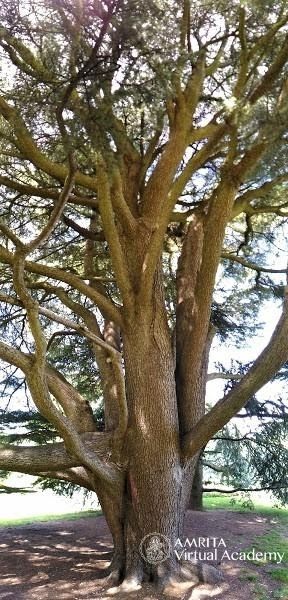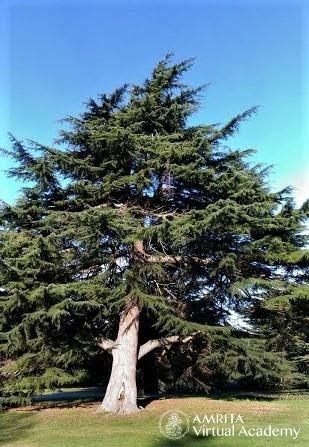
Communicating With Nature
Om Amriteswaryai Namah
As part of our blog series on communicating with Nature, I thought I would share with you an extraordinary experience I had talking with a tree a few years ago. I have always had a strong relationship with trees, as a young girl I would spend hours in the tree in our back garden, and created entire imaginary houses inside the big trees in our local parks. Trees were my refuge in many ways.
A couple of years ago I was in Northern California, living next to a huge Madrone Tree. Out of the blue one day we sparked up a conversation – it’s not unusual for me to talk to trees, I’m sure you’ll hear more about that in future blog posts! This tree was so engaging and willing to communicate that I just continued asking questions as long as this beautiful tree was willing to answer.
At first, I asked the tree, do you communicate with other trees and plants the way that I’m communicating with you. It showed me that there were ‘guilds’ of plants, and that the communication happened between plants that belong to the same guild. Which guild you belonged to had a lot to do with size and function. I was shown a strong community essence between the plants in each guild, and a kind of network that connected them, helping each individual plant feel like it was a part of something bigger.
“There was a sense of togetherness and community that was deeply nurturing.”

This particular tree that I was talking to was in a forested area, with some human habitation but lots of nature. I started to suggest that it must be very comforting for these plants when they lived in close communion with each other, such as in the forest and it agreed. There was a sense of togetherness and community that was deeply nurturing. Inquisitively, I asked about the trees that were alone – like when a farmer just leaves one or two trees in the middle of a large field, and my Madrone friend showed me that they all feel really sad for that tree and send it as much communion as they can – through a kind of underground web. Unfortunately, I got the sense that it is not the same and those trees that are alone do have a much more isolated and uncomfortable experience than the trees in the forest.
I was fascinated by this, because it gave me the sense that trees have ‘feelings’ and I got really curious. Do trees also have senses? Do they also feel in the way that we feel?
I proceeded to ask this beautiful Madrone tree a series of questions, and the answers were quite amazing. I asked about the sense of touch, and immediately the tree zoomed in to show me that it is aware of even a tiny ant crawling on it’s surface. That is how sensitive it’s touch-receptors are!
I asked about listening/sound and it showed me that every single tiny sound vibration passes through the tree and each leaf and branch ‘feels’ it – it’s not quite like having human ears, but I could experience the way the tree ‘heard’ for a moment and it was very beautiful. It actually showed me that the way that we use sound around plants can have an effect on them, that intense noises are very jarring, even for the big trees. I got to see that trees and plants feel appreciative of those who are conscious of how they use/express sound when in nature!
When it came to the eyes and sight, I suppose I assumed that the tree would have to say ‘no, we don’t see’ but in reality it showed me how each leaf registers every nuance of light and dark, how the whole system responds very much like the pupils of our eyes respond to darkness as well as to bright light.
“This tree was blowing my preconceptions right out of the water.”

This tree was blowing my preconceptions right out of the water. This being was so closely aligned to my experience, even though our forms expressed life in such profoundly different ways. When it came to the sense of taste, I couldn’t imagine how the tree would respond. It seemed willing to keep communicating, so I kept exploring! Taste was fascinating, because even though very different from our taste which happens only with the tongue, there was awareness of the different qualities of what was being absorbed through the roots. And at the same time, the leaves had sensitivity to the water and other substances that would fall on them.
The tree was able to perceive when the air around was smoky, foggy etc through the interaction between the leaves and the air. This related to our sense of smell, even though the receptors in the tree were different than the way we receive smell through our noses. I had no idea that the trees were sentient in such a similar way to our human sensing, that they are registering sensory input, communicating and expressing connection in a way that has a lot of similarities to us humans!
Writing this post in the middle of lockdown, when luxuriating in nature is a distant memory, is such a great reminder to me of the power of communicating with my plant friends, and how much closer it brings me to the whole of life. Our modern world believes concepts that allow us to impose on nature, and imagine it to be less sentient than we are and therefore less valuable. If this post inspires you, consider this an invitation to go on your own exploration of talking to nature and learning the lessons she has to teach you, it is always such a gift every time I’m willing to stop and listen!
Click here to see all our Gardening courses.
Check out this TED Talk below where Canadian researcher Suzanne Simard has scientifically proven that trees do in fact communicate and support one another cooperatively.
